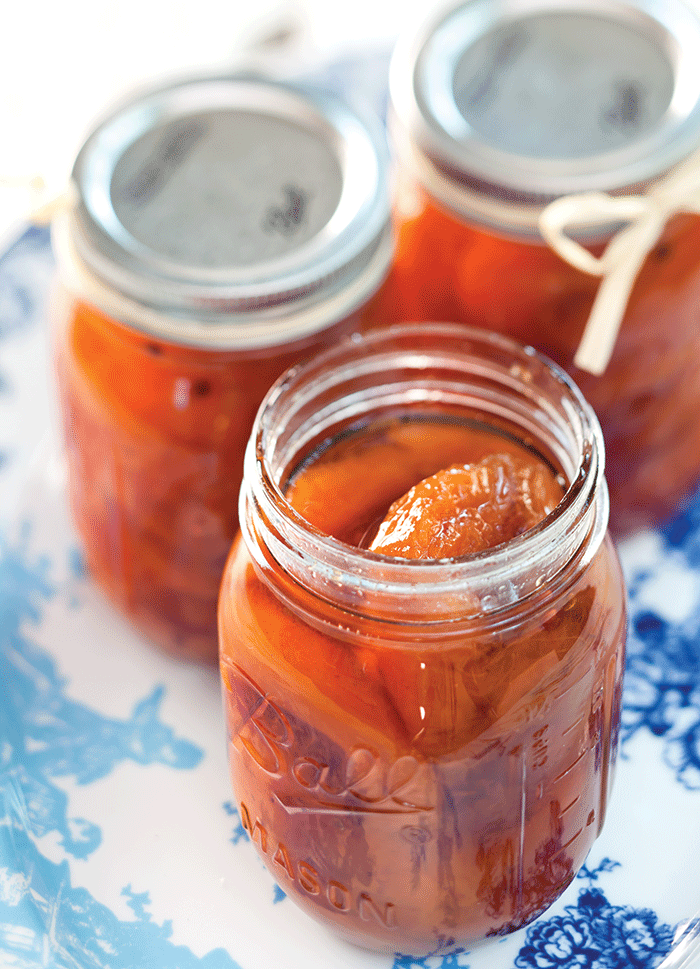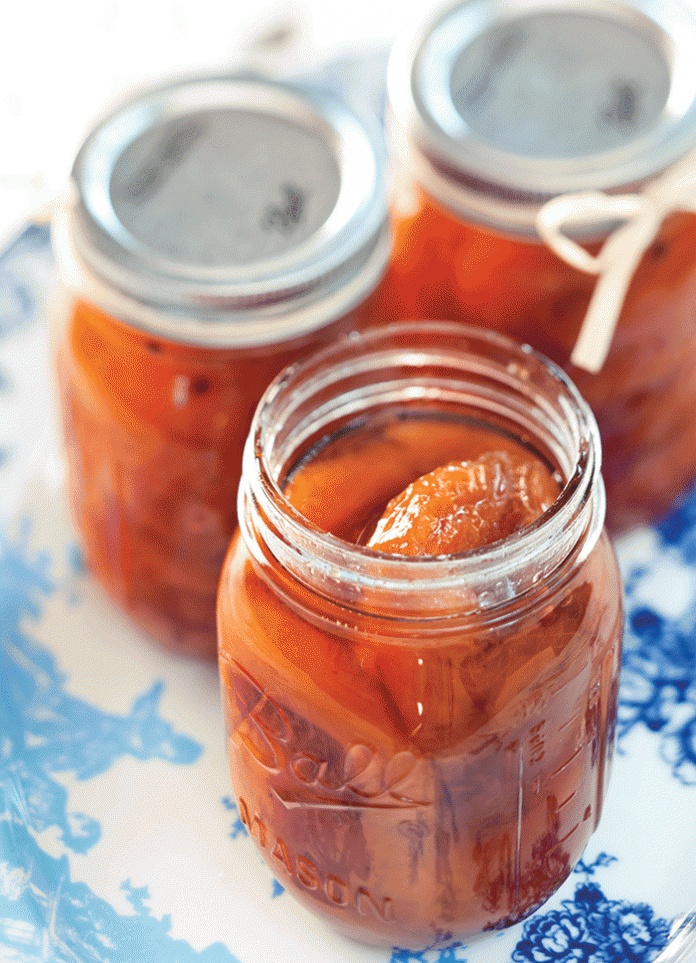Fresh ginger, whole cloves, and pink peppercorns sprinkle these pickled peaches with just the right amount of spice!

Ginger Pickled Peaches
2014-09-06 01:11:49

Yield: approximately 5 (1-pint) jars
Ingredients
- 16 cups peeled, pitted, and quartered peaches
- 1⁄4 cup fresh lemon juice
- 4 cups water
- 2 tablespoons whole cloves
- 2 tablespoons pink peppercorns
- 1 tablespoon peeled and chopped fresh ginger
- 6 cups sugar
- 4 cups distilled white vinegar
Instructions
- In a large glass bowl, combine peaches, lemon juice, and water.
- In a large stainless-steel saucepan, combine cloves, peppercorns, ginger, sugar, and vinegar. Bring to a boil over medium-high heat, stirring until sugar dissolves. Reduce heat to medium, and simmer for 5 minutes. Add peaches, and increase heat to medium-high. Simmer until peaches are tender, 8 to 10 minutes. Remove from heat. Cool to room temperature. Cover, and refrigerate for 8 hours to overnight.
- Prepare boiling-water canner, jars, rings, and lids. (See below.)
- Bring peach mixture to a boil over medium-high heat.
- Pack hot peaches into hot jars, leaving a little more than 1⁄2-inch headspace. Pour liquid over peaches, leaving 1⁄2-inch headspace, making sure peaches are completely covered. Remove air bubbles, and adjust headspace by adding more liquid, if necessary.
- Wipe rims with a clean dish towel. Place lids on jars, and screw on rings until fingertip tight.
- Process jars, covered, over high heat for 20 minutes. (Start timing when water in canner returns to a boil.) Make sure jars are covered by at least 1 inch of water.
- Turn off heat, and remove canner lid. Let jars rest in canner for 5 minutes.
- Remove jars from canner, and place on a clean dish towel. Let jars rest undisturbed for 24 hours.
Taste of the South https://tasteofthesouthmagazine.com/
How to Use a Boiling-Water Canner
2014-09-06 01:19:04
Follow these steps for successful canning.
Ingredients
- Canning jars
- Boilng-water canner or large stockpot
Instructions
- Preparing the jars and closures: Wash the jars, lids, rings, and utensils in hot soapy water.
- (Remember: You can reuse rings, but you should not use lids more than once.) Place on a clean towel to dry.
- Heating the jars: Place the canning rack in the bottom of a boiling-water canner (or a large stockpot that does not exceed the width of your stove eye by more than 2 inches). Arrange on the rack the jars you plan to use. Fill the canner with enough water to cover the jars by at least 1 inch. Place the lid on the canner, and bring to a simmer (180°) over medium heat. Boiling the jars is not necessary.
- Preparing the closures: Set the rings aside. (They should be at room temperature for easier handling.) In a large saucepan, bring water to a simmer (180°) over medium heat. Add lids. Do not let lids come to a boil, as this can break down the rubber seal, allowing air into the processed cans and contaminating the recipe.
- Making the recipe: While you are waiting for the water in the canner to come to a simmer, prepare the recipe. (Some recipes may require more time, so read ahead and be prepared.) The hot food should be poured into the jars just as the jars come out of the hot water. If the food is not ready when the jars have reached a simmer, keep the jars hot in the water until the recipe is complete.
- Filling the jars: Working with one jar at a time, remove from water, using rubber-tipped tongs; drain completely. Place on a clean dish towel. Pour the hot, prepared food into the hot jar, using a clean funnel if necessary.
- Be sure to leave the specified amount of headspace. (Too little headspace can cause the seal to break and the food to become contaminated.) Using a clean plastic or wooden spatula, run the spatula along the sides of the jar and in the center of the food to remove any air bubbles. Wipe the rim of the jar with a clean dish towel. Remove the lids from the hot water, and place one on the jar. Place a ring over the lid, and screw until fingertip tight. Using tongs, return the jar to the hot water. Repeat process with remaining jars and ingredients.
- Processing the jars: Add water to the canner if necessary. (Water should cover jars by at least 1 inch.) Bring water back to a boil, and process for the amount of time specified in the recipe. (Start timing when water returns to a boil.) Turn off the heat, and remove the canner lid.
- Cooling the jars: Let the jars rest in the water bath for 5 minutes. Using tongs, remove the jars from water, and place on a clean dish towel to cool. Let the jars rest undisturbed for 24 hours.
- Checking the vacuum seal: After 24 hours, remove the bands, and press down on the lids. Sealed lids will curve downward and will not move when pressed. Jars that don’t seal properly should be refrigerated and used within a few days.
Notes
- Source: Ball Complete Book of Home Preserving (© 2006 Robert Rose Inc., robertrose.ca)
Taste of the South https://tasteofthesouthmagazine.com/





This recipe looks so good—thank you for sharing it! Do you think I could add cinnamon and nutmeg, with less cloves? Not a big clove fan, lol. If so, how much do you think I could add to the recipe, if I still added a few cloves? Thanks so much!